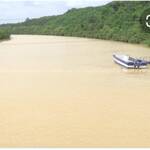The issue of illegal small-scale mining, or galamsey, has once again become a critical point of public discourse in Ghana.
Illegal mining has severely impacted the country, with vast areas of land and water bodies damaged, particularly in mining communities.
Amid the growing environmental crisis, the Ghana Medical Association (GMA) and several health unions have urged President Akufo-Addo to impose an immediate ban on all small-scale mining operations, legal or illegal.
Their appeal highlights the urgent need to address the ongoing destruction of forests and water bodies, as well as the looming public health risks posed by galamsey.
60% of water bodies polluted
The Water Resources Commission (WRC) estimates that about 60% of Ghana’s water bodies are polluted, primarily in the south-western regions where illegal mining is prevalent.
Some affected water bodies
Rivers such as the Pra, Ankobra, Birim, and Black Volta have been severely contaminated, leading to dire consequences for aquatic life and clean water availability for communities.
In the Central Region, particularly around Cape Coast, illegal mining has also impacted water sources.
This pollution threatens food security, public health, and agricultural activities.
Caution against blanket ban
Mr Martin Kwaku Ayisi, Chief Executive Officer (CEO) of the Minerals Commission, however, has warned that a blanket ban on small-scale mining would not resolve the issue.
He argues that the scarcity of authorized mining sites is a root cause of illegal mining and that regulating unlicensed activities is a more sustainable solution.
Mr Ayisi emphasized that community leaders and local authorities must play a significant role in tackling the menace, as the government’s efforts alone have not sufficed in halting the environmental destruction.
Health unions warning
The GMA and several health unions, including the Ghana Registered Nurses and Midwives Association (GRNMA) and the Government and Hospital Pharmacists Association (GHOSPA), demand swift action to prevent an imminent environmental disaster.
In a joint statement, they warned that failure to act promptly would result in severe threats to the health and future of the nation.
The unions demanded that the government equip security agencies to enforce regulations and prosecute violators swiftly. They also urged political parties to publicly commit to fighting illegal mining by signing formal declarations.
As environmental and health concerns mount, the path forward will require collaborative efforts between the government, local communities, and industries to restore the nation’s natural resources and secure its future
Lands devastated
Despite the efforts to regulate the sector, galamsey continues to devastate large areas of land
34 forest reserves destroyed
Data from the Forestry Commission shows that galamsey in 34 forest reserves out of 288 forest reserves has caused significant damage.
4,726.2 hectares destroyed in forest reserves
According to the data, the total mapped area of the 34 forest reserves illegally mined amounted to 4,726.2 hectares.
547,891.70 hectares cultivated
A total of 547,891.70 hectares of degraded forest lands were cultivated between 2017 and 2021.
157,300 hectares cultivated in 53 years
This represents a 348.3% increase and is far in excess of the 157,300 hectares of degraded forest lands cultivated between 1963 and 2016, a period of 53 years.
Breakdown of 309 protected areas
There are 309 protected areas, comprising 266 gazetted forest reserves, 22 proposed forest reserves, and 21 wildlife protected areas.
The 309 protected areas totalled 3.6 million (3,682,406) hectares.
The breakdown is as follows: gazetted forest reserves – 2,135.359 hectares, proposed forest reserves – 199,447 hectares and wildlife protected areas -1.3 million (1,347,600) hectares.
Forest cover
The forest cover increased from 5.8 million (5,803,571.62) hectares in 2015 to 6.6 million (6,615,224.25) hectares.
Closed forest declined from 1.4m to 1.2m hectares
Closed forest declined from 1.4 million (1,450,873.68) hectares in 2015 to 1.2 million (1,200,626.27) hectares.
Open forest increased from 4.5m to 5.4m hectares
On the other hand, open forest increased from 4.5 million (4,352,697.94) hectares in 2015 to 5.4 million (5,414,597.99) hectares.
Over 28,000 hectares lost each year between 2010 and 2015
Available data also shows that between 2010 and 2015, Ghana lost, on average, over 28,000 hectares of forest each year, peaking at 35,000 hectares in 2014, largely due to illegal mining and illegal logging.
- Friday, March 28, 2025 Newspaper Headlines - 28 March 2025
- MTN Ghana donates to Chief Imam to Support Eidul Fitr Celebrations - 28 March 2025
- Oxfam Ghana, GHS train 36 healthcare professionals - 28 March 2025

